When is Being Green Not a Good Thing?
Toxic algal slime (credit: Lake Improvement Association)
When is "being green" not a good thing? Answer: when the color appears in lakes and marine environments produced by toxic algae.
Nitrogen, phosphorus, and potassium (N-P-K) are essential nutrients for plant growth. These minerals fertilize plants in your garden and cultivated crops like corn, soybeans, and canola. Plants are inefficient at the uptake of these agro-chemicals, made from fossil fuel feed-stocks, and large amounts of nitrogen and phosphorus inputs, are wasted and drain away from farm lands. The chemistry flows into rivers and lakes where it becomes a water pollution issue. This is particularly true in the mid-western USA where large scale agriculture is the standard production method. One result of this external fertilizer is to create 'dead zones' from toxic algal blooms that can occur in ponds, lakes, and extend into the oceans.
NOAA, and its remote sensing partners NASA and the European Space Agency (ESA) have monitored the impacts of algal blooms in the Great Lakes region for multiple years. The Agency calculates an index of severity to measure the biomass of blue-green algae (cyanobacteria) in a bloom. A severity level 5 and above indicates algal concentrations that can cause the worst environmental impacts. Over the past decade, the largest blooms occurred in 2011, with a severity index of 10; 2015 of 10.5; and 2017 determined at level 8. An index has not been released so far this year.
The largest extent of toxic algae so far measured was in Lake Erie. The bloom in 2011 was severe enough to shut down the drinking water supply for Toledo, Ohio. Microcystins, produced by the algae, were detected in the city's drinking water. According to the Environmental Protection Agency (EPA), microcystins can: damage the liver if ingested while other symptoms include diarrhea, nausea, and dizziness as well as irritated skin, eyes, and throat". Harmful Algal Blooms, or HAB's for short, require Don't Drink the Water warnings to be posted. Satellite imagery offers visual detail of the water pollution in Lake Erie itself with indications of growth appearing elsewhere in Great Lakes. This is not the quality of water you want to drink or use for taking a shower.

Lake Erie Severe Algae Bloom, 10-8-2011 (NOAA)

Great Lakes Algal Blooms, Spring 2016 (credit: NOAA)
The cause and effect consequences of the simple linkage between agro-chemical fertilization of plants and toxic algal blooms is well understood. Excess nitrogen and phosphorus from region-wide agriculture remains the driving forces for the production of such blooms. Oxygen levels in lake water can drop so low, fish die from being unable to breathe. A mass die-off results. An ecological tipping point is reached when a living system receives an external pressure, like over-fertilization, and it "tips" beyond its ability to recover. This impact can occur rapidly, sometimes in a matter of days or weeks in the case of toxic blooms.
Regenerative agriculture, or agro-ecology, where soil structure, conservation, and cultivation practices are less damaging, is one new approach that could reduce fertilizer run-off from fields. The benefits of this approach have not been initiated at a scale which could make a significant difference so far. Efforts are underway to address 'scalability' and reduce the frequency of blooms.
The immediate threats from the toxic algae in Lake Erie, other Great Lakes, and coastal zones dissipates during the fall and winter months when fields lie fallow. The causes of "green pollution" remain and insures future toxic blooms. This situation is ugly on many levels. WHB